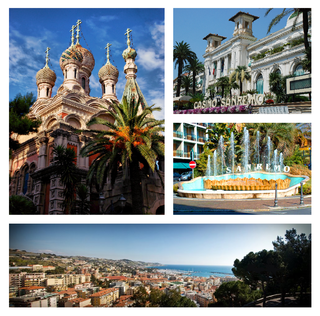
The Italian Riviera or Ligurian Riviera is the narrow coastal strip in Italy which lies between the Ligurian Sea and the mountain chain formed by the Maritime Alps and the Apennines. Longitudinally it extends from the border with France and the French Riviera near Ventimiglia eastwards to Capo Corvo which marks the eastern end of the Gulf of La Spezia and is close to the regional border between Liguria and Tuscany. The Italian Riviera thus includes nearly all of the coastline of Liguria. Historically the "Riviera" extended further to the west, through what is now French territory as far as Marseille.

Sanremo or San Remo is a comune (municipality) on the Mediterranean coast of Liguria, in northwestern Italy. Founded in Roman times, it has a population of 55,000, and is known as a tourist destination on the Italian Riviera. It hosts numerous cultural events, such as the Sanremo Music Festival and the Milan–San Remo cycling classic.
The music of Sicily is created by peoples from the isle of Sicily. It was shaped by the island's history, from the island's great presence as part of Magna Grecia 2,500 years ago, through various historical incarnations as a part of the Roman Empire, then as an independent state as the Emirate of Sicily then as an integral part of the Kingdom of Sicily and later the Kingdom of the Two Sicilies, and, finally, as an autonomous region of the modern nation state of Italy.
Naples has played an important and vibrant role over the centuries not just in the music of Italy, but in the general history of western European musical traditions. This influence extends from the early music conservatories in the 16th century through the music of Alessandro Scarlatti during the Baroque period and the comic operas of Pergolesi, Piccinni and, eventually, Rossini and Mozart. The vitality of Neapolitan popular music from the late 19th century has made such songs as'O Sole mio and Funiculì Funiculà a permanent part of our musical consciousness.

As one moves away from Naples in almost any direction, there is prominent musical activity to be found. These include, for example, the restoration and use of a number of the so-called "Vesuvian villas" in and near Ercolano, a string of once luxurious villas built in the 18th century and severely damaged by aerial bombardment in World War II. The most prominent of these is the Villa Campolieto, already restored, open and the site of chamber concerts by the Alessandro Scarlatti association.
Veneto is one of the 20 regions of Italy. The music of Veneto.
The music of Genoa includes a number of important musical venues. Genoa, a major port, is the capital of the region of Liguria and in the 19th century aspired to recognition as a cultural center more in keeping with its role as a major city in the history of the Risorgimento, the political, social, and military movement that eventually led to the unification of the modern nation state of Italy.
The Music of Abruzzo is a style of music in Abruzzo, Italy. Abruzzo is sparsely populated and is very mountainous, but the area has a musical history involving opera, sacred music, and even the town band. The great composer of delicate, 19th-century airs, Francesco Paolo Tosti, dedicated a series of compositions to the area, the romanze abruzzesi.

The Music of Emilia-Romagna has the reputation of being one of the richest in Europe; there are six music conservatories alone in the region, and the sheer number of other musical venues and activities is astounding. The region, as the name implies, combines the traditions of two different, contiguous areas—Emilia and Romagna—and it is perhaps this blend that contributes to the wealth of musical culture.
Besides Milan, the region of Lombardy has 10 other provinces, each named for the largest city and capital of the respective province: Bergamo, Brescia, Como, Cremona, Lecco, Lodi, Mantova, Pavia, Sondrio, and Varese. Musically, they offer:

The Teatro Carlo Felice is the principal opera house of Genoa, Italy, used for performances of opera, ballet, orchestral music, and recitals. It is located on the side of Piazza De Ferrari.
Svetlana Smolina is a Concert pianist.

Piazza De Ferrari is the main square of Genoa. Situated in the heart of the city between the historical and the modern center, Piazza De Ferrari is renowned for its fountain, which was restored in recent years along with a major restyling of the square.
Aldo Ferraresi was a celebrated Italian concert violinist and violin pedagogue.

Genoa is a city in and the capital of the Italian region of Liguria, and the sixth-largest city in Italy. In 2023, 558,745 people lived within the city's administrative limits. While its metropolitan area has 813,626 inhabitants, more than 1.5 million people live in the wider metropolitan area stretching along the Italian Riviera.
Giovine Orchestra Genovese is an Italian music organization, concert society and cultural association, founded in 1912 in Genoa by Giovanni Semeria. A nonprofit organization, it organizes and produces classical and chamber music concerts and promotes musical education for students.

Pavel Berman is a violinist and conductor of Russian origin, laureate of international competitions.
Alvise Casellati is an Italian conductor.

The Paganini Theater was an Italian theater, located in Genova. Inaugurated in 1855, it was situated on the central Via Caffaro. After less than a century of activity, between October 23 and 24, 1942, it was destroyed during the bombardments on Genova in World War II.








